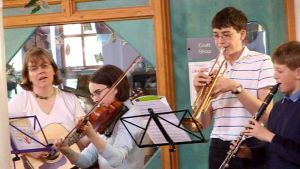This story illustrates the principles of The UP dimension of church in the Guide.
 When an Alpha course on a north Oxfordshire housing estate came to an end during 2003, the 24 members wanted to carry on with their Thursday evening meetings, led by pioneer minister to the estate, Ian Biscoe.
When an Alpha course on a north Oxfordshire housing estate came to an end during 2003, the 24 members wanted to carry on with their Thursday evening meetings, led by pioneer minister to the estate, Ian Biscoe.
Ian began to explain to the new Christian community – residents on an estate formed out of a former US air base – ‘what church means’, including communion.
The first time we talked about communion, I put out the chalice, patten, bread and wine,
Ian recalls. The community had been used to the Alpha tradition of eating together each week and rounding off with After Eights. Ian added a plate of After Eights to the display to demonstrate how communion would be a development of the sharing they had already experienced.
Everyone just sat and looked at the stuff on the table,
Ian recalls. The ensuing discussion showed that the significance of the display had not been lost on the new church community, but also that there was a strong feeling of unworthiness.
On a later occasion, the community was planning a celebratory meal. One member, a New Age seeker, suggested passing round bread and wine. Since Ian, a Church Army officer, is not ordained, he discussed the possibility with the ordained minister with whom he shares responsibility for the estate. They decided to turn the meal into an agape supper, which Ian describes as
a biblical re-enactment rather than communion.
Communion was a development of the sharing they had already experiencedI am very careful not to do what I’m not licensed to do within the Anglican church,
Ian explains.
So in the agapes I pointed out that we were exploring together what Christ meant.
On a later date, a clip of the Last Supper from the film Jesus of Nazareth was shown, after which bread and wine was passed, without liturgy, round a circle.
Both events were
hugely powerful,
Ian says.
They were clearly something very very important for people.
This ‘long period of time exploring together’ developed into a monthly service of communion which continues to be experimental. The ordained minister comes to preside, taking the service in a variety of Christian traditions – for example, fully robed, using Ignatian meditation, or in the Brethren style of approaching the table when ready.
This variety is important, Ian says, because of the mix of people within this new worshipping community (which meet in a former military chapel). Some of the 40-plus members have no church background, others a Church of England or Roman Catholic background, others a free church experience.
By developing its understanding of the significance of communion, this pioneering church is finding a way to become a sacramental community without a full-time ordained minister.

